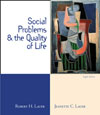CHAPTER 5 Crime and Delinquency
The Varieties of Crime (pp. 145-152) Crime is a social problem that pervades our society and includes both respectable
and unrespectable citizens. Respectable citizens not only commit crimes themselves,
but they are, directly and indirectly, parties to others' crimes. To see our
total crime picture, we must examine different varieties of criminal behavior.
Lauer and Lauer divide criminal behavior into a number of categories: predatory
crime-acts that have victims suffering loss of property or some kind of
physical harm; illegal service crime that involve such "services" as
drugs or prostitution; public disorder crime that have no specific victim
but do offend the public; crimes of negligence that involve an unintended
victim or potential victim such as a person injured by reckless driving; computer
crime illegal acts for which knowledge of computer technology is used to
commit the offense; white-collar crime which involves illegal activities
committed by respectable people in the course of their work; and juvenile
delinquency, including youthful offenders, status offenders, and minors
in need of care. Since most people tend to translate the word crime into
predatory crime ( rape, robbery, burglary, and so forth) many people are surprised
to learn that crimes of negligence and public disorder comprise the bulk of
police work in this country. Although some criminologists consider white-collar crime to be a form of predatory
crime, the authors treat it separately. The term itself was coined by Edwin
Sutherland, who described such offenses as crimes committed by respectable people
in the course of their work. In reality, the matter is more complex than this,
because many practices are not adequately covered by the criminal law and fit
into a marginal area of social control. The authors also discuss organized crime as involving numerous groups having
varying amounts of areas where they have control or influence. Organized crime
will remain part of American life so long as illicit goods and services are
in demand. The Extent of Crime and Delinquency (pp. 152-157) This section turns to a discussion of the extent of crime and juvenile delinquency.
There are three basic data sources: official records, victimization studies,
and self-reports. The best known and most widely used of all these is the official
publication of the U.S. Department of Justice, Federal Bureau of Investigation
the Uniform Crime Reports. This is an essential document for any criminologist,
but it does contain certain weaknesses, including an underestimation of crime
in America. The additional emphasis on victim reports and self-reports provides
important supplementary data as well as missing pieces in our national crime
puzzle. This section ends with a discussion of the amount of crime and the distribution
of crime in terms of residence, age, race, sex, and region. The Criminal Justice Process (pp. 158) The path from the reporting of crime to the final settlement is long and complex.
Once a crime has been reported, it must be investigated, and the suspect must
be identified and apprehended. Then, the suspect is either released or charged.
A suspect who is charged is supposed to be taken before a judge or magistrate
without delay and if the offense is serious, a preliminary hearing is scheduled.
If there is probable cause, then indictment takes place: Once the indictment
is filed, the accused is scheduled for arraignment, when a plea will be entered;
plea bargaining may take place. Trial follows, either by judge or by jury. If
there is a conviction, the defendant has a right to appeal. Crime, Delinquency, and the Quality of Life (pp. 159-161) Widespread crime contradicts our values of freedom from fear, of well-being,
and of the right to keep one's personal property. It further diminishes the
quality of life by exacting physical, psychological, and economic costs. From
the criminal's point of view, however, crime may permit the use of an illegitimate
route to obtain rewards supposedly promised to all in the land of opportunity.
When this occurs, it represents what Merton would describe as crime resulting
from anomie. Even with the falling crime rates during the 1990s, research suggests that
38 percent of Americans living in urban areas say they are afraid to walk alone
at night in an area near where they live. Fear alone is not the only element
here, for we must also consider the price of distrust and lowered social morale.
People can become very cynical about social institutions under the impact of
white-collar crime and the possible corruption of leadership, including police,
judges, and even officials in the White House. It can be argued that white-collar
crime may be more damaging than the common offenses of larceny, burglary, and
robbery. Contributing Factors (pp. 162-170) Like crime itself, the factors that generate and sustain crime involve both
respectable and unrespectable elements of our society. Among the social structural
factors are the following: the age structure of the population--a disproportionate
amount of crime is committed by young males; there are "hot spots" from certain
crimes; norms are important in reference to crime; the politics of control are
important (prison); the family background of offenders is significant; and social
stratification plays a role. Among the social psychological factors are the
attitudes of respectable people toward various forms of crimes. What Is to Be Done? (pp.171-175) Lauer poses the question of whether we should try to reduce crime by punishing
criminals or by rehabilitating them. There are contrasting points of view concerning
capital punishment. Among the innovative alternatives mentioned are system diversion
programs, private prisons, and intensive probation supervision. Crime prevention
is not just a matter of official action: Communities can become involved and
act to reduce crime. A relatively recent effort to deal with some of the effects
of crime involves aid to victims. | 


 2002 McGraw-Hill Higher Education
2002 McGraw-Hill Higher Education